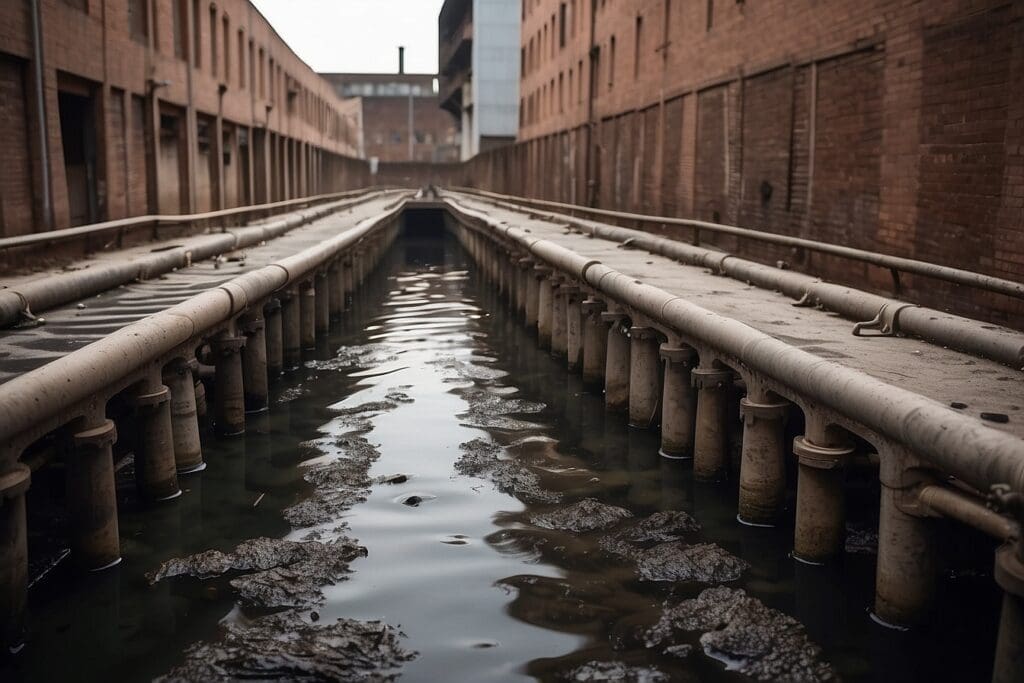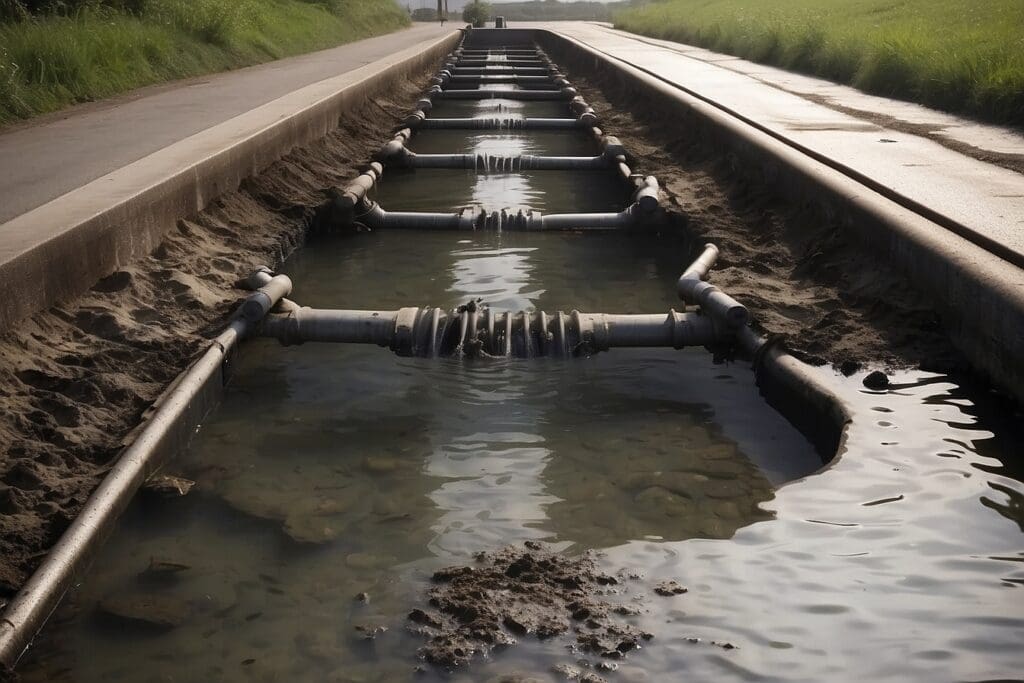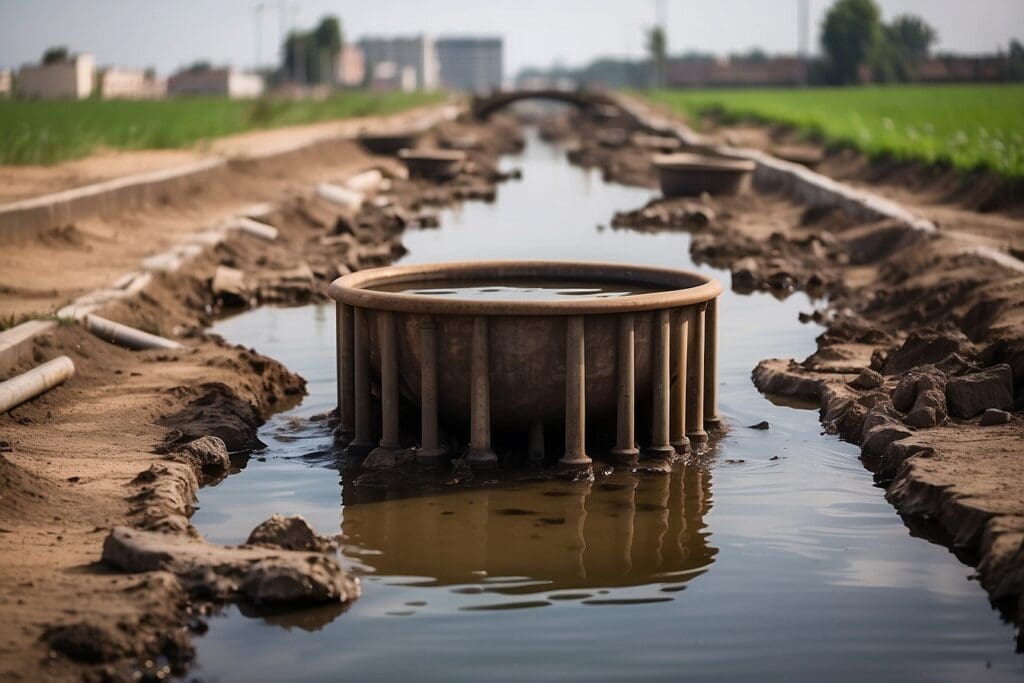As water is becoming increasingly scarce the world is considering new and controversial solutions to this shortage. One of these solutions is converting sewage water to potable water, and this process has been put into place in select areas in the United States and around the world. This may sound disgusting to some, I know, but don’t write off this method just yet. First see how it works and then decide if you could stomach consuming your refined toilet water.
The Process (from Withdrawn US Patent 3692076)

1. First, the sewage water is diverted through a filter to separate out the big stuff that is easy to see like trash and sand.
2. The sewage is divided out into sludge–the really heavy and nasty part of sewage–and the effluent, which is basically the rest of the sewage that has been treated in a septic system, so the liquid part of sewage. The effluent contains minerals as well as organic compounds. Since the effluent is what will eventually become potable water, we are going to ignore the sludge’s fate for now.
3. The effluent flows away from the sludge to an area where it is treated with active carbons to remove organic compounds. How this works, in laymen’s terms, is pretty much basic chemistry: the carbon is positively charged so it is in need of negative charges in order for it to be a happy and stable element. The carbon will absorb electronically charged organic compounds in the wastewater, casing them to be absorbed by the carbon. It is crucial to continually replace the carbon molecules since they will eventually become saturated with these compounds they take in.
4. The effluent–now absent of organic compounds–then is transported with a counter-current made up of a hot hydrocarbon liquid. (I know this is getting complicated, but stay with me because it will all make sense soon.)
5. Now this hot, hydrocarbon liquid is heated with the effluent to about 600-700 degrees Fahrenheit (about triple the temperature of boiling water) and under a pressure of 1000-3000 pounds per square inch which is about the same pressure as air in a scuba tank. The point of all this physical intensity is to create a variety of things, the important one being a hydrocarbon-water solution that lacks minerals and heating the water so hot does so effectively. (The reason why the water-hydrocarbon solution will boil and not be converted into steam is because of the immense pressure it is under; water’s boiling point increases as surrounding pressure increases, therefore water is able to reach extreme temperatures without evaporation when pressure is around, say 1000-3000 pounds per square inch.)
6. The water is then separated out from this solution of hydrocarbons. Note that since the water is very hot, it can be passed through tubes to be used for space heating. By virtue of physics, the water cools.
7. Finally, the cool, purified water is chlorinated, and alas! Potable water is produced
A quick review: liquid sewage is separated out, stripped of the minerals and organic compounds, heated to a temperature no man has gone before, becoming water that is cooled and chlorinated.
After all this chemistry and physics mumbo-jumbo, do you believe harmful water borne diseases can still survive?
Spores, Bacteria, Protozoa and all that other stuff you don’t want
Microbes are notoriously crafty creatures. The knarrliest ones can live in the deep sea under a world of pressure or live in a state of hibernation in the Arctic Circle. These microorganisms are known as extremophiles and are sometimes even thought to be from another planet! But no need to worry, theses Nebulon micro-foes are not waterborne illnesses found in fecal matter which we are concerned with. Ours are way easier to exterminate. The Center for Disease Control (CDC) ranks these four diseases as the largest concern for contaminated drinking water: Cryptosporidiosis, E. coli, Giardia, and Hepititus A. Some of these diseases, like cryptosporidiosis can survive chlorination so it is important as a sewage treatment plant to do more than just add chemicals to sewage.
The CDC states that waterborne illness will be almost entirely eliminated when water is boiled. Using a chemical cleaning agent such as bleach or chlorine will also aid in microbial destruction. And if you remember, the process for converting sewage to potable water reaches over 600 degrees Fahrenheit, which is about three times the boiling temperature of water! Seems pretty safe so far, right? But are you convinced?
The Regulations

Because this process is so controversial, regulation for diseases must be strict and constant. And the Environmental Protection Agency is on top of their game when it comes to microbial control.
The Safe Water Drinking Act was passed in 1974. It established a Maximum Contaminant Level that says that drinking water must have minimal contamination with almost no health risks associated with consumption. This Act even takes into account peoples more prone to illnesses such as babies, the elderly, and people with weakened immune systems. Although this level is based on technological availability and economic viability, regulations for microbial contents are not allowed to be compromised. All communities must have the same level of microbial standards despite their sizes or budgets.
The Surface Water Treatment Rule is a zero-tolerance policy for microbes in drinking water. Meaning that 99.99% of harmful microbes must be expelled from all potable water.
The Total Coliform Rule applies to all public water system and states that only 5% of samples taken from potable water are allowed to contain coliform bacteria. Coliform is a group of bacteria, mostly harmless, that live in the immune system of many creatures like humans, so it is a good indicator species for water treatment because it shows how effective water treatment systems are operating. This microbe is one you need to look out for in sewage conversion plants because it is a bacteria that commonly represents sewage contamination of clean water.
The Long Term 2 Enhanced Surface Water Treatment Rule (LT2) is a standard set by the EPA that is specifically designed for controlling illnesses in potable water. While current regulations require that 99% of Cryptosporidiosis–the disease with the largest concern due to its resistively to chlorine–must be removed from drinking waters, the LT2 does not believe that this amount is sufficient due to the illness’s high level of contractibility. Cryptosporidiosis and E. Coli levels must be monitored for two years at least on a monthly basis. This rule stresses over and over strict microbial levels and accepts nothing less than perfect scores of zero for microbial percentage content.
What I am trying to convey here is that the EPA understands the importance of clean water. There are many more regulations on water purity as well amendments to sharpen the severity of water monitoring. So even if the EPA is doing their part to restrict microbial contents in our drinking water, why do we need to convert sewage? How desperate is the world to find new sources on clean water?
Water Scarcity
The World Health Organization reports that about 40% of people around the globe are affected by water scarcity. This is even becoming apparent in areas in the United States, like in the Bay Area in Northern California, where residents are being asked to reduce their water usage so there will be enough to support Southern California, which depends on waters from the north state. The Western United States is still suffering from a drought and water wars (like the controversy between Arizona and California) are emerging. World wide, fresh water is lacking because of the continued world population boom and contamination of clean water from pollution, natural disasters–which are becoming more common due to global climate change–, or an inability of societies to pay for sanitation. There have even been articles published saying that water is the new oil, meaning availability will drop and price will rise.
The Test
Talk and possibility of converting sewage to potable water shows how technology is advancing to support a world that is running low on a resource that should be a right, not a privilege. Using sewage water seems pretty disgusting, I am not going to lie about that. As a species we are instinctually prone to be disgusted by foul smelling water and food because our bodies know that diseases are contracted from these. So after immense processing measures to boil, chlorinate, carbon-bind, and rigorously and routinely testing it, as well as adding exact regulations, are you ready to test it out? What more water treatment measures and government regulations could be enacted in order to convince you that, yes, this water is finally clean enough for you to drink? Are there anymore steps that need to be taken, or is it just a psychosocial boundary that needs to be jumped? The truth is that this process is very safe. Maybe it is about time we swallowed our species’ pride and said okay to an economically and environmentally positive solution to a very serious problem.
Sources and resources to check out for more information:
• US Patent 3692076 (for process; this patent has been withdrawn)
• EPA.gov
• WHO.org
• theguardians.com/Microbiology/gm_mbm04.htm#therm (for extremophiles)
• nytimes.com/2007/11/27/us/27conserve.html?_r=1&hp&oref=slogin





